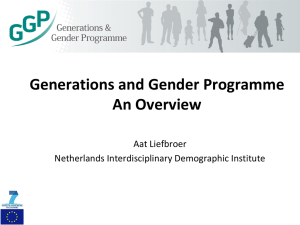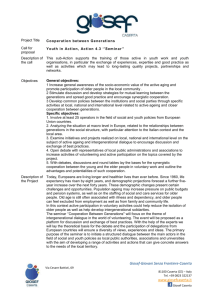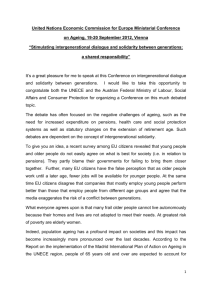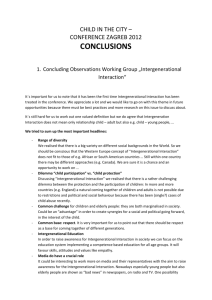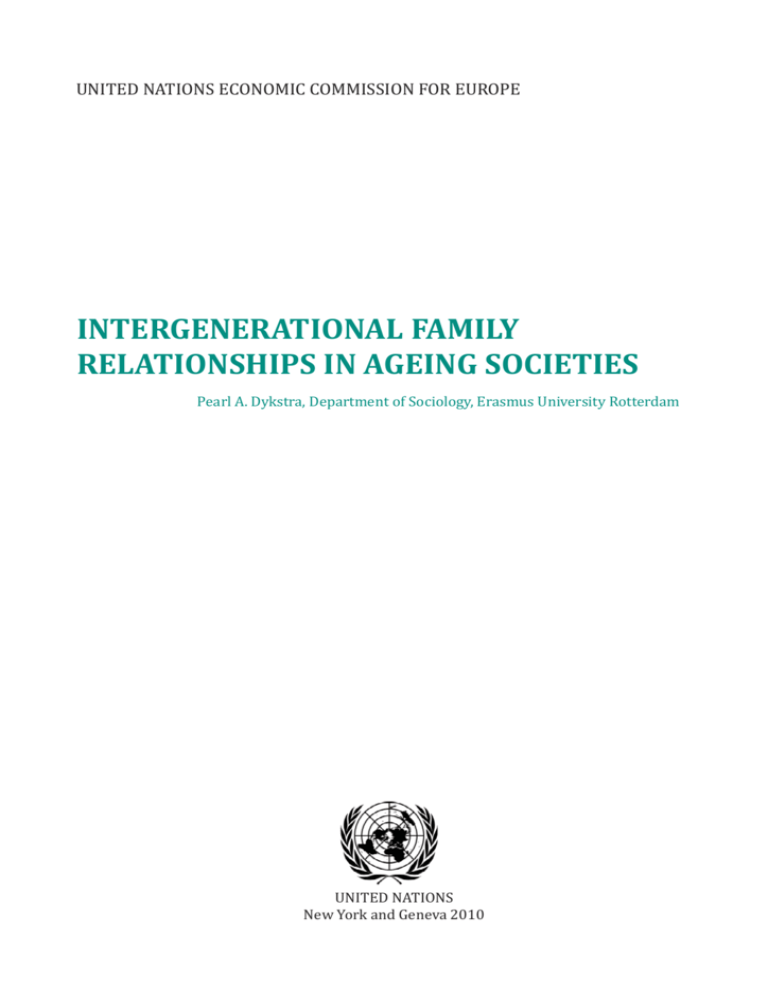
UNITED NATIONS ECONOMIC COMMISSION FOR EUROPE
INTERGENERATIONAL FAMILY
RELATIONSHIPS IN AGEING SOCIETIES
Pearl A. Dykstra, Department of Sociology, Erasmus University Rotterdam
UNITED NATIONS
New York and Geneva 2010
ACKNOWLEDGEMENTS
The author gratefully acknowledges colleagues Wolfgang Keck, Aafke Komter, Nienke Moor, Allan Puur,
Chiara Saraceno, and Niels Schenk from MULTILINKS for their analyses of GGP-data and of policy and
legislative frameworks in Europe. MULTILINKS (How demographic changes shape intergenerational
solidarity, well-being, and social integration: A multilinks framework) is a research programme funded
through the seventh framework programme of the European Commission (grant number 217523).
NOTE
The designations employed and the presentation of the material in this publication do not imply the
expression of any opinion whatsoever on the part of the Secretariat of the United Nations concerning the
legal status of any country, territory, city or area, or of its authorities, or concerning the delimitation of its
frontiers or boundaries.
This publication has been produced with the financial assistance of the European Union.
The views expressed in this publication are those of the authors and do not necessarily reflect the views of
the United Nations Economic Commission for Europe or the European Union.
UNECE Information Unit
Palais des Nations
CH-1211 Geneva 10
Switzerland
Phone:
Fax:
E-mail:
Website:
+41 (0)22 917 44 44
+41 (0)22 917 05 05
info.ece@unece.org
http://www.unece.org
UNITED NATIONS PUBLICATION
Sales No. 10.II.E.13
ISBN: 978-92-1-117030-6
Copyright © United Nations, 2010
All rights reserved
Printed at United Nations, Geneva (Switzerland)
P
REFACE
In the region of the United Nations Economic Commission for Europe (UNECE), population ageing
is the dominant demographic trend of this century. Simultaneously, other pertinent demographic
developments such as declining fertility, increasing age at family formation, and changing family
patterns also challenge many areas of public policy. The policy responses have to include reconciliation
of work and family life and measures to facilitate flexibility in life-course transitions among education,
work and retirement. Equally important is to promot intergenerational solidarity and collaboration,
and ensure gender equality in family, community and society at large.
In the UNECE Regional Implementation Strategy for the Madrid International Plan of Action
on Ageing (2002) and in the León Ministerial Declaration “A Society for All Ages: Challenges and
Opportunities” (2007), UNECE member States have committed themselves to respond to challenges
and opportunities of their ageing societies. In 2008, UNECE established the Working Group on Ageing
– an intergovernmental body with the mandate to coordinate and streamline implementation of
major international policy documents on ageing. In order to provide knowledge base for population
policy measures, the UNECE initiated in 2000 and continue to coordinate the Generations and Gender
Programme (GGP). GGP has two main pillars: the first pillar is the system of national Generations and
Gender Surveys (GGS), and the second pillar is the contextual database that provides information on
macrolevel factors influencing demographic trends. GGP also serves as an important source of data in
various programme elements of the Working Group on Ageing.
One of the many international research initiatives based on GGP data is the Multilinks project led
by the Netherlands Interdisciplinary Demographic Institute. Multilinks is specifically designed to
support sound policymaking through new insights into how changing social contexts are affecting
social integration and intergenerational solidarity in different European countries. Relying on the
conceptual framework of that project, and based on the examples of policies and programmes from
UNECE countries, the Working Group on Ageing held an in-depth discussion on intergenerational
relationships at its second meeting in 2009. This report is derived from this in-depth discussion.
It also summarises the most relevant research findings in the area of intergenerational family
relationships.
UNECE is grateful to the author and UNECE member States for contributing to this report. UNECE also
wishes to acknowledge the financial support from the European Commission, which was essential for
establishing and functioning the Multilinks research project.
It is expected that this report will be of interest to a broad audience concerned with matters of
intergenerational relationships, and will increase awareness about the need for policy measures for
promoting greater solidarity among family members of all ages.
Ján KUBIŠ
Executive Secretary
United Nations Economic Commission for Europe
i
C
ONTENTS
PREFACE ................................................................................................................................................................................................................................................................................................................................................. i
I. - KEY PREMISES ................................................................................................................................................................................................................................................................................................. 1 - 2
II. - THE DEMOGRAPHY OF
F INTERGENERATIONAL
INTE
IN
T RG
GENERATIONAL FAMILY RELATIONSHIPS...................................................................... 3 - 5
A.
B.
C.
Multiple
Multipl
p e family
pl
faami
m ly
y generations
gen
neratt io
ons
Thee sandwich
sand
sa
ndwi
wich
wi
ch generation
geen
nerrat
ation
Vertical
Veert
r t ic
ical
al deprivation
dep
d
epri
ep
riva
ri
v ti
va
t ion
o
III.
II
I. - INTERDEPENDENCIES
I.
INT
INT
N ER
RDEPE
DEPE
PEND
ND
DEN
NCI
CIE
ES BETWEEN
ES
BET
ETWE
WEEN
E OLDER
OLD
L ER AND YOUNGER
YOU
UNGER FAMILY
FAM
AM
MILY MEMBERS
ME
EMB
M ERSS ............................................
.............
....................................
..
7 - 11
A.
B.
C.
C.
Opportunity
Oppor
ppor
pp
o tu
tuni
nity
ni
ty structure
sstr
truc
uctu
uc
ture
tu
r
Normative
Norrm
No
r mat
ativ
iv
ve obligations
ob
bliiga
gati
tion
ons
on
A
Ac
Actual
t ual
tu
al exchanges
exc
xcha
hang
ha
ngges
e
IV. - GENDERED INTERGENERATIONAL
INT
TER
ERGE
GEN
GE
NE ATIION
NERA
O AL R
REGIMES
EGIM
EG
MES
ES...........................................................................
.................................................................................................................................................................
.....
. .................................................
. ..................................... 13 - 14
A.
Three
Thr
hree
hr
ee p
pat
patterns
atte
at
tern
te
rn
ns in legal
leg
e al and
and policy
policy arrangements
a raanggements
ar
B.
Legal
Leg
egal
al aand
nd p
policy
olic
ol
icc y ar
arrangements
r rang
n em
ments are
r nott neutral
neutr
trral
V -P
V.
POL
POLICY
OLIC
OL
I Y IMPLICATIONS
IC
IM
MPL
LIC
ICAT
ATIO
AT
ION
NS .......................................................................................................................................................................................................................................................
.......
...........
....
.......
.......
........
...
....
.. ............
....
...
.........
... .................................
................................................................................................................................................................................................ 1
15
5 - 16
VI. - REFERENCES
REFE
RE
FE
ERE
R NCESS............
........................................................................................................................................................................................................................................................................................
.........
.. ....
.......
.......
.............
..........
........
.........
... ....
....
........
.. ....
....
........
........
....
. ..........
. ......................
....
. ....
........
........
........
................
........
........
........
.....................................................................................
. ........................................................................ 17
17 - 19
List of figures
ffiigure
es
Figure
Figu
Fi
g ree 1 :
gu
Ad
Adults
dul
ults
t aage
ts
aged
ged
ge
d 20–80,
20–8
20
–8
80,
0 by numb
number
berr o
off fa
fami
family
mily
mi
ly generations,
ggen
en
nerat
erattions
er
ion , GGPio
GGP-countries
-co
c untriess....................................................................
......................................................................... 4
Figure
Fiigu
gure
re 2 :
Mean
family
generations,
GGP-countries
M
ean
n number
num
n
umbe
um
berr off descending
be
descending fa
de
fami
m ly ggen
mi
ener
erratio
i ns, GGP
P-coun
untr
un
t iees ........................................................................................
. ........
. ........................
. ...................................................... 4
Figgu
gure
r 3:
Figure
Me
ean
n number
num
umbe
beer of ascending famil
ly generations,
geenerations,
s GGP-countries
GG
GP-coun
ntrriess ..........................................................................................
...................................
. .......................................................... 5
Mean
family
Figure
Figu
gu
ure 4 :
Agreement
with
that
Ag
gre
reem
emen
ent
en
nt wi
ith
t the statement tha
at “Children
“Chiildren should
ld
d ttake
ake responsibility
resp
spon
o sibiili
l ty
y forr
caring
parents
need”,
GGP-countries
carrin
ing for
ffo
or their
thei
th
eirr parents when their
ei
ir p
aarren
e ts are in ne
n
ed
d”, GG
GP-countriess ........................................................
GP
...............
.. ....
. ........
..............
.. ......................... 8
Figure
Figu
Fi
gure
ree 5 :
Agreement
Ag
grreeeem
men
ent with the statement that “Children
“Chi
hild
hi
ld
dren should
shou
uld
l aadjust
djustt their
theirr working
th
work
wo
rkin
ingg
lives
lives
iv
vess to
to the
the needs
n eds of their parents”,, GGP-countries
ne
GGP
GP-c
P-c
-coun
ntries .........................................................................................................................................
................
...........
........
........
.......
... ....
........
........
........
....
.......
... ...
....
..........
... ........
........
.. ........
........
.......
.. ...
........
........
........
........
........
..............
..................
........
..............
...... 9
Figu
Fi
gure
re 6 :
Figure
Pr
Prop
opor
orti
tiion
o o
off me
men
n an
and
d wo
wome
men
n ag
aged
ed 1
18–
8–80
80 p
pro
rovi
vidi
ding
ng p
per
erso
sona
nall care
care
Proportion
women
18–80
providing
personal
to parents,
pare
pa
rent
ntss GGP-countries
GGP
GP-c
-cou
ount
ntri
ries
es .............................................................................................................................................................................................................................. 10
to
Figure 7 :
Proportion of men and women aged 18–80 providing emotional support
to parents, GGP-countries .............................................................................................................................................................................................................................. 11
iii
P
ART
I
KEY PREMISES
The new demographic circumstances in which
family members of multiple generations share
several decades together compel us to recognize
that individuals are embedded in a complex web
of vertical and horizontal ties. Thus, a second key
premise is that there are critical interdependencies
between family generations and between men and
women in families, which are built and reinforced
by social policies. These interdependencies should
not be taken for granted as is often done. Rather,
it is important to address explicitly the ways in
which legal and policy arrangements constitute
differential opportunities and constraints for men
and women and across generations in families.
Debates on ageing societies predominantly focus
on the circumstances of the elderly. A change of
focus is needed, and one that starts from three
key premises.
First, population ageing is not only about older
persons: it affects people of all ages. In debates
on ageing societies, there seems to be an implicit
assumption that demographic ageing primarily
affects older persons, their economic situation,
health, mobility, social integration, family support
and care. Of course, increasing longevity and
decreasing birth rates have resulted in larger
numbers of older persons both in absolute and
relative terms. Nevertheless, with dramatic shifts
in the balance between old and young, the worlds
of younger age groups are profoundly changed.
The young are growing up in societies where they
are a numerical minority and where they have
several generations of family members “above”
them. These considerations suggest that attention
should be given to people of all ages.
A third key premise is that to understand
interdependencies in families, a spectrum of
levels and units must be distinguished and
recognized: country, historical generation, family,
dyad (partners, parent-child) and the individual.
Countries have disparate political, religious
and economic histories and different welfare-
1
Intergenerational family relationships in ageing societies
generations and between men and women in families
and allowing cross-national and longitudinal
comparisons.
State arrangements. To understand the impact of
demographic changes on people’s lives, it is not
sufficient to consider cross-national differences
only. Regional diversity, including urban-rural
differences and social change over time must also
be considered — the rapid changes in Central and
Eastern Europe being a case in point.
This report details selected findings from
MULTILINKS (http://www.multilinks-project.eu/),
a research programme funded through the Seventh
Framework of the European Commission in which
GGP-data are analysed. This research programme
examines:
Under the auspices of the Population Activities Unit
(PAU) of the United Nations Economic Commission
for Europe (UNECE) in Geneva, a system of nationally
comparative surveys and contextual databases
has been developed, which aims at improving the
knowledge base for policymaking. The Generations
and Gender Programme (GGP) is a unique datacollection effort covering the entire adult age range
that is being carried out in a wide range of countries,
including non-Western nations (United Nations
Economic Commission for Europe, 2007). The GGP
is ideally suited to empirically address questions on
intergenerational relationships in ageing societies
— taking people of all ages into consideration,
explicitly considering interdependencies between
(a)
Multiple linkages in families (e.g., transfers
up and down family lineages, interdependencies
between older and younger family members);
(b)
Multiple linkages across time (measures at
different points in time, at different points in the
individual and family life course); and
(c)
Multiple linkages between, on the one hand,
national and regional contexts (e.g., policy regimes,
economic circumstances, normative climate,
religiosity) and, on the other hand, individual
behaviour, well-being and values.
2
P
ART
II
THE DEMOGRAPHY OF INTERGENERATIONAL FAMILY RELATIONSHIPS
A.
childbearing means, on the other hand, that the
age gap between generations is relatively large,
which in turns reduces the likelihood that multiple
generations are alive at the same time.
Multiple family generations
The conventional portrayal of family change under
the influence of demographic trends is that the
extension of life and the drop in birth rates result
in “beanpole” families with relatively many vertical
ties and relatively few horizontal ties (Bengtson,
2001). Contrary to popular belief, vertically
extended families with four or five generations
alive at the same time are not the norm (see figure
1). The majority of adults are members of threegeneration families. Increased longevity and
postponed childbearing have opposing effects on
the generational structure of families (Matthews
& Sun, 2006; Watkins, Menken & Bongaarts,
1987). The extended lifespan means, on the one
hand, that older family members are living longer
than they did in the past, which in turn suggests
that three, four or even five generations of family
members may be alive at the same time. Delayed
GGP-data make it possible to examine the
opposing effects of increased longevity and
postponed childbearing on the generational
structure of families. For example, figure 1 shows
that the proportions in one-, two-, three- and
four-generation families are virtually identical in
France and in Russia. The underlying demographic
processes are quite different, however, as is
illustrated in figures 2 and 3. In France, where
people tend to live long lives, adults have relatively
many ascending family generations. In Russia,
where people tend to have children at a young age,
adults have relatively many descending family
generations.
3
Intergenerational family relationships in ageing societies
Figure 1
Adults aged 20–80, by number of family generations, GGP-countries
100%
90%
80%
70%
≥4
60%
3
2
1
50%
40%
30%
20%
10%
0%
Netherlands
France
Germany
Bulgaria
Georgia
Estonia
Russia
Figure 2
Mean number of descending family generations, GGP-countries
2
Russia
1.8
Estonia
Georgia
1.6
Bulgaria
Germany
France
Netherlands
1.4
1.2
1
0.8
0.6
0.4
0.2
0
20-24
25-29
30-34
35-39
40-44
45-49
4
50-54
55-59
60-64
65-69
70-74
75-79
Intergenerational family relationships in ageing societies
Figure 3
Mean number of ascending family generations, GGP-countries
2
Russia
Estonia
Georgia
Bulgaria
Germany
France
Netherlands
1.8
1.6
1.4
1.2
1
0.8
0.6
0.4
0.2
0
20-24
B.
25-29
30-34
35-39
40-44
45-49
The sandwich generation
50-54
55-59
60-64
65-69
70-74
75-79
grandchildren, it tends to disregard transfers
received from older and younger generations. Yet,
older generations often serve as significant sources
of support and help for young families, through
financial transfers, caring for young children and
provision of practical help (Albertini, Kohli, & Vogel
2007; Attias-Donfut, Ogg & Wolff, 2005). In addition,
young adults should not be solely looked upon as
dependants, but also as givers of support and care
to their parents and grandparents.
Research gives little credence to the metaphor of
the “sandwich generation”, the men and women
caught between simultaneous responsibilities for
their parents and children (Agree, Bissett & Rendall,
2003; Dykstra & Komter, 2006; Rosenthal, MartinMatthews & Matthews, 1996). Adults typically
occupy middle-generation positions between the
ages of 30 and 60. This is not a period in life when
both young children and elderly parents are likely to
need care simultaneously. For those in the younger
part of the age-range (i.e., those with childcare
responsibilities), parents are not at high risk of
frailty. For those in the older part of the age range
(i.e., those that might be caring for their parents),
their children will generally be leading independent
lives already. Though researchers have repeatedly
demonstrated that the metaphor of a sandwich
generation juggling care commitments towards
parents and children is clearly a misconception of
midlife, it continues to figure prominently in public
and policy debates.
C.
Vertical deprivation
Little attention has been paid to middle generation
individuals who are “vertically deprived” in the sense
that they have no children or grandchildren, or no
surviving parents or grandparents (Connidis, 2010;
Dykstra & Hagestad, 2007). Moreover, whereas an
examination of childbearing and mortality patterns
informs us about the existence of biological kin, an
examination of divorce and separation provides
insight into a different form of vertical deprivation,
that is, having severed ties. Men are more likely
to have broken family ties than women (Dykstra,
1997; Kalmijn, 2007; Kaufman & Uhlenberg, 1998;
Lin, 2008).
Whereas the literature on the middle generations
typically considers transfers upwards to
ageing parents and downwards to children and
5
P
ART
III
INTERDEPENDENCIES BETWEEN OLDER AND YOUNGER FAMILY MEMBERS
A.
Opportunity structure
political differences (Billari, 2004; Hank, 2007;
Saraceno, 2008; Tomassini, Glaser, Wolf, Broese
van Groenou, & Grundy, 2004). The prevalence of
co-residence of older parents with their children
is lowest in the Scandinavian countries and the
Netherlands, highest in the Mediterranean and
South-East European countries, while intermediate
levels are reported for Central Europe. Coresidence patterns provide little insight into the
question of who is supporting whom. Most adults
in co-residential arrangements have always lived
with their parents.
Geographic proximity facilitates face-to-face
contact, which in turn increases the likelihood
of exchanges of help in kind (Soldo & Hill, 1993).
Frequent face-to-face contact not only reduces
the costs of giving, but also helps to make support
providers aware of recipients’ needs. Exchanges
of financial support are less affected by distance
because they do not require interaction in person
(Litwak & Kulis, 1987).
Intergenerational co-residence (i.e., adults living
with their parents) is among the strategies that
can be adopted to organize support, economic
and otherwise.1 There are large variations across
Europe in the rate of intergenerational coresidence, reflecting historical, cultural and socio-
B.
Normative obligations
Family obligations are generalized expectations
about family members’ responsibilities for each
other (Finch & Mason, 1990). They are socially
shared and have a normative component. Not
only do they reflect the cultural climate in which
people live, but also the individual circumstances
1
The centrality of intergenerational co-residence was evident
in the reports of the delegates reporting on intergenerational
policies in Armenia and Kyrgyzstan.
7
Intergenerational family relationships in ageing societies
The answers to questions about people’s wishes
for care and about the types of care people are
prepared to give, provide insight into the extent to
which policy measures are in keeping with public
attitudes. They also offer tools for developing policy
that enables or promotes the application of personal
preferences.
in which they find themselves (Daatland &
Herlofson, 2003; Finley, Roberts, & Banahan, 1988;
Gans & Silverstein, 2006). Family obligations are
of interest because they are predictive of support
behaviour: they predispose people to behave in a
certain way. Elderly American parents who strongly
agreed with the view that family members should
support each other were found to provide their
children with more practical and financial help than
parents who did not share this view (Lee, Netzer, &
Coward, 1994). Another American study showed
that young adults who felt highly responsible for the
well-being of their parents gave their parents more
practical support than young adults with a weaker
sense of responsibility (Stein, Wemmerus, Ward,
Gaines, Freeburg, & Jewell, 1998). Research in the
Netherlands has shown that the more strongly older
adults and their adult children felt that children
and parents should support each other, the more
instrumental support the parents received (Klein
Ikkink, Van Tilburg, & Knipscheer, 1999).
Is there correspondence between public opinion
and policies? Support for norms of family obligation
tends to be lower in generous welfare States
(Daatland & Herlofson, 2003).2 This pattern is
observed in figures 4 and 5, which show the strength
of feelings of filial obligations among younger and
older adults in different GGP-countries. Figure 4
measures responses to the statement, “Children
should take responsibility for caring for their parents
when their parents are in need”. Inhabitants of East
European countries are more likely to endorse that
statement. A stronger east-west contrast emerges
2
The delegate from the Czech Republic rightfully pointed out
that cause and effect are difficult to unravel here. Have weak
feelings of family obligation been the basis for developing public
care services, or does the availability of public care services allow
people to refrain from endorsing responsibility for dependent
family members?
Family obligations are also of interest because they
serve as a source of information for policymakers
(Van Bavel, Dykstra, Wijckmans, & Liefbroer, 2010).
Figure 4
Agreement with the statement that “Children should take responsibility for caring for their parents
when their parents are in need” (0, strongly disagree; 4, strongly agree), GGP-countries
4
18-54
55-80
3.5
3
2.5
2
1.5
1
0.5
0
Bulgaria
Romania
Russia
Hungary
8
France
Germany
Netherlands
Intergenerational family relationships in ageing societies
Figure 5
Agreement with the statement that “Children should adjust their working lives to the needs of their
parents”(0, strongly disagree; 4, strongly agree), GGP-countries
3
18-54
55-80
2.5
2
1.5
1
0.5
0
Bulgaria
Romania
Russia
Hungary
Germany Netherlands
Haberkern & Szydlik, 2010; Ogg & Renaut, 2006).
Earlier work has rarely included East European
countries, where co-residence of generations is
widespread.
in reaction to the assertion “Children should adjust
their working lives to the needs of their parents”
(figure 5). The latter alludes to greater commitment
and sacrifice on the part of children. Given the more
limited public welfare system in Eastern as opposed
to Western European countries, it should not come
as a surprise that Bulgarians, Russians, Romanians
and Hungarians more strongly believe that it is
important to provide help to family members in
need than do the Dutch, Germans and French.
Compared to previous data-collection efforts, the
GGP has the advantage that it includes East European
countries and has information on exchanges with
family members both in and outside the household.
Figure 6 shows the proportion of adult men and
women who answered “yes” to the question “Over
the last 12 months, have you given [your mother
and/or father] regular help with personal care such
as eating, getting up, dressing, bathing, or using
toilets?” Of the entire adult population, fewer than
5 per cent are involved in the provision of personal
care to parents. The likelihood of providing personal
care to parents is higher in East European than in
West European countries, but the cross-national
differences are not large. Figure 7 shows the
proportion of adult men and women who answered
“yes” to the question “Over the last 12 months,
has [your mother and/or your father] talked to
you about [his/her/their] personal experiences
and feelings?”, which is an often-used measure of
emotional support. Taking all countries together,
approximately 11 per cent of adults emotionally
Intergenerational interdependencies are also
formalized in family responsibility laws. Maintenance
obligations both upwards and downwards are
quite widespread in Europe and, depending on the
country, involve differentiated sets of relatives and
generational levels (Saraceno & Keck, 2008).
C.
France
Actual exchanges
Patterns of exchange in families tend to be described
in terms of a north-south gradient. Intergenerational
transfers of time and money among non-co-resident
family members tend to be less frequent in the Nordic
than in the Southern European countries, with the
Continental European countries being somewhere
in the middle (Albertini, Kohli and Vogel, 2007;
9
Intergenerational family relationships in ageing societies
supported their parents in the past year. Clear eastwest differences are not observed.
welfare systems. More support has been found
for the “complementarity” hypothesis, indicating
that generous welfare States enable families to
redistribute their resources and to provide the
kind of care that they are best equipped to provide
(Haberkern & Syzdlik, 2010; Kohli , Kunemund,
Motel, & Szydlik, 2000; Lowenstein & Daatland,
2006; Motel-Klingebiel, Tesch-Roemer, & Von
Kondratowitz, 2005).
____________________
Figures 6 and 7 underscore the gendered nature
of exchanges in families: daughters tend to be
more heavily involved than sons in providing care,
domestic assistance and emotional support to
ageing parents. Gendered roles stressing daughters’
kin-keeping and daughters’ presumed expertise in
carrying out, what their societies regard as typically
feminine tasks related to care giving, are among the
underlying mechanisms (Gerstel & Gallagher, 2001;
Horowitz, 1985).3
3
The delegate from Sweden described measures that are being
introduced by the national Ministry of Health and Social Affairs to
get more men interested in pursuing careers in elderly care. The
measures will of course not only benefit men, but also women
working in care services and the health field. They include the
introduction of minimum skill requirements, a nationally recognized
job title and career specializations, such as in caring for patients
suffering from dementia, palliative care, rehabilitation, and meals
and nutrition.
The direction of intergenerational support flows
is primarily downward. Parents become net
beneficiaries of help only at an advanced age. The
“substitution” hypothesis — the view that public
transfers crowd out private transfers — has received
little empirical support in studies of Western
Figure 6
Proportion of men and women aged 18–80 providing personal care to parents, GGP-countries
6
men
women
5
4
3
2
1
0
France
Germany
Bulgaria
10
Romania
Georgia
Russia
Intergenerational family relationships in ageing societies
Figure 7
Proportion of men and women aged 18–80 providing emotional support to parents, GGP-countries
25
men
women
20
15
10
5
0
France
Germany
Bulgaria
Romania
11
Georgia
Russia
P
ART
IV
GENDERED INTERGENERATIONAL REGIMES
A.
Three patterns in legal and policy
arrangements
To understand to what degree country-specific
institutional frameworks support the desire to be
responsible towards one’s children and frail old
parents and/or support individual autonomy,4
thereby partially lightening intergenerational
dependencies and the gender division of labour,
three patterns in legal and policy frameworks have
recently been distinguished (Saraceno, 2010):
____________________
4
The Portuguese delegate emphasized that caring for children
and caring for frail elderly persons should not be treated as
separate policy issues. The split between policy communities
addressing the young and their families and those focusing on the
old, have led to a neglect of similarities and interdependencies
between young and old. in pursuing careers in elderly care. The
measures will of course
(a)
Familialism by default: no publicly
provided alternatives to family care and financial
support;
(b)
Supported
familialism:
policies,
usually through financial transfers, support
families in keeping up their financial and care
responsibilities;
(c)
Defamilialization: needs are partly
answered through public provision (services,
basic income).
This categorization goes beyond the public/
private responsibilities dichotomy, showing that
public support may both be an incentive for and
lighten private, family responsibilities (Saraceno,
Keck, & Dykstra, 2009). Generous parental leaves
support parental care and, in the case of the
presence of a father’s quota, support the caring
13
Intergenerational family relationships in ageing societies
role of fathers, thus de-gendering family care
while supporting the “familialization” of fathers
(Brandth & Kvande, 2009). Childcare services
instead lighten — without fully substituting —
parental care and education responsibilities.
At-home care, day care or institutional services
for the frail elderly partly substitute for family
care. The same occurs when payments for care
for the frail elderly partly substitute for family
care. The same occurs when payments for care
can only be used to hire someone in a formal way.
Non-earmarked payments for care support informal
family care but also encourage recourse to the
informal sector for paid caregivers, as is happening
in some Southern European countries (Ayalon,
2009).5
B.
polarize women of different social classes and
income resources because women who opt for
extensive leaves tend to have poorer prospects
on the labour market. However, generously paid
leaves, with a reserved father’s quota, support the
desire to provide care to family members and at the
same time can help de-gender it (Brandt & Kvande,
2009). The issue therefore is not long leaves versus
services, but rather the balance between the two,
together with flexibility in the use of leaves.
As another example, childcare services are not only
a conciliation measure helping parents (mothers)
to remain in the labour market. Good quality
services are also a resource for children themselves,
helping them to widen their relationship with other
children and other adults in an ageing society and
to overcome the impact of social inequalities on
cognitive development (McLanahan, 2004).
Legal and policy arrangements are not
neutral
The packaging of gendered intergenerational
obligations varies greatly across countries, as it
has varied across time, shaping different contexts
in which intergenerational family relationships are
played out. Legal norms and social policies are not
neutral. They impose dependencies that limit the
autonomy of men and women, or on the contrary,
support the choice to assume intergenerational
obligations (Leira, 2002; Saraceno, 2010). For
instance, long parental leaves might strengthen the
gendered nature of family care, given the prevalent
gender division of care tasks and the differential
wages of men and women. They might also further
With regard to elder care, over-reliance on the family
via either supported familialism or familialism by
default crystallizes the gender division of labour
also in the third age (Saraceno, 2010). It may
prove inefficient in the middle and long term, since
population ageing — combined with women’s
labour market participation, marriage instability,
low fertility and childlessness — is creating a caring
deficit within families. Furthermore, exclusive or
primary reliance on family care is in contrast with the
goals of higher women’s labour force participation
and longer working lives for both men and women
(Esping-Andersen, 2009).
____________________
5
The Italian delegate described several policy measures aimed
at improving the situation of migrants providing care in private
households.
14
P
ART
V
POLICY IMPLICATIONS
A number of messages for policymakers emerge
from the previous overview. The first is that
there is little evidence of “moral hazard” (Wolfe,
1989), the notion that people are less inclined
to care for family members if public provisions
are available. Empirical studies have repeatedly
failed to find that provisions of the welfare State
crowd out family care. With regard to elder
care, specialization emerges, with professional
providers taking over the medically demanding
and regular physical care and family providing
the less demanding, spontaneous help (Brandt,
Haberkern, & Szydlik, 2009). With regard to
“downward” family support, monetary welfare
provisions enable family members to respond to
those with the greatest financial needs (Schenk,
Dykstra, & Maas, forthcoming).
A second message is that interdependencies
between generations and between men and women
in families are built and reinforced by the legal
and policy arrangements in a particular country.
Laws define the relationships of dependence and
interdependence between generations and gender,
whereas policies reward or provide disincentives
for particular family patterns. A consideration of
legal norms and public policies draws attention
to cultural specificity. Countries differ in their
understanding of “proper” intergenerational
family relations (Saraceno, Keck, & Dykstra,
2009). Policymakers should critically examine
the ways in which caring responsibilities for the
young and the old have been allocated between
the family and the collectivity. To what extent
do country-specific institutional frameworks
impose dependencies which limit the autonomy
of individuals? To what extent do they support the
choice to assume intergenerational obligations?
Such a critical examination calls for a “holistic”
approach to policymaking: a serious consideration
15
Intergenerational family relationships in ageing societies
of the ways in which public family provisions (or
the lack thereof) create differential opportunities
for individual autonomy for young and old, men and
women.
“use it or lose it” criterion promotes equal sharing
of parenting responsibilities between men and
women (Organisation for Economic Co-Operation
and Development, 2007).
A third message is that national policies should
seek to support intergenerational care regimes
without reinforcing social class inequalities and
gender inequalities. One of the issues is whether
policies should involve payments for care, (paid)
leaves, or the provision of care services. The policy
measures have different implications that need to
be considered carefully. For example, when public
support is offered in money rather than in kind,
trade-offs between using it to buy services or to
keeping it for the family budget while providing
care directly are different for families in different
socio-economic circumstances (Saraceno, 2010).
The strategy of staying at home to provide care
is more likely to be adopted by members of the
working class (in practice, working class women),
reducing their ability to remain in the labour
market and hence creating the conditions of oldage poverty for themselves. Another example
pertains to a father quota in paid leave schemes. A
The fourth message is that women’s integration in
the labour force has taken place without fundamental
changes to the formal and informal rules associated
with the breadwinner model, which served as the
basis for the organization of the labour market
and the welfare State (Esping-Andersen, 2009).
The structural discrepancy between the role of
the breadwinner model in the organization of paid
work and unpaid care, on the one hand, and the
increased labour force participation of women, on
the other hand, is the source of tensions and stress,
as witnessed in dropping fertility rates, marital
instability, intrafamily conflict and even emotional
burn out. To help resolve this discrepancy, policies
should consider how to get men more involved with
caring. Men should not be discouraged from taking
care leaves, and men should come to realize that
intergenerational responsibilities throughout their
working life are the norm, not the exception.
16
R
EFERENCES
Agree, E. M., Bissett, B., & Rendall, M. S. (2003). Simultaneous care for parents and care for children
among mid-life British women. Population Trends, 112, 27-34.
Albertini, M., Kohli, M., & Vogel, C. (2007). Intergenerational transfers of time and money in European
families: Common patterns — different regimes? Journal of European Social Policy, 17, 319-34.
Attias-Donfut, C., Ogg, J., & Wolff, F.-C. (2005). European patterns of intergenerational financial and time
transfers. European Journal of Ageing, 2, 161-73.
Ayalon, L. (2009). Family and family-like interactions in households with round-the-clock paid foreign
carers in Israel. Ageing & Society, 29, 671–686.
Bengtson, V. L. (2001). Beyond the nuclear family: The increasing importance of multigenerational
bonds. Journal of Marriage and Family, 63, 1-16.
Billari, F. C. (2004), Becoming an adult in Europe: A macro (/micro)-demographic perspective.
Demographic Research, Special Collection, 3, 16-44.
Brandth, B., & Kvande, E. (2009). Gendered or gender-neutral care politics for fathers? The ANNALS of
the American Academy of Political and Social Science, 624, 177-189.
Connidis, I. A. (2010). Family ties and aging (second edition). London: Sage, 2010.
Daatland, S. O., Herlofson, K. (2003). “Lost solidarity” or “changed solidarity”: A comparative European
view of normative solidarity. Ageing & Society, 23, 537-560.
Dykstra, P. A. & Hagestad G. O. (2007). Roads less taken; developing a nuanced view of older adults
without children. Journal of Family Issues, 28, 1275-1310.
Dykstra, P. A., & Komter, A. E. (2006). Structural characteristics of Dutch kin networks. In P. A. Dykstra,
M. Kalmijn, T. C. M. Knijn, A. E. Komter, A. C. Liefbroer & C. H. Mulder (Eds.), Family solidarity in the
Netherlands (pp. 21-42). Amsterdam: Dutch University Press.
Dykstra, P. A. (1997). The effects of divorce on intergenerational exchanges in families. The Netherlands’
Journal of Social Sciences, 33, 77-93.
Esping-Andersen (2009). The unfinished revolution: Welfare state adaptation to women´s new roles.
Cambridge, UK: Polity.
Finch, J., & Mason, J. 1990. Filial obligations and kin support for elderly people. Ageing and Society, 10,
151-175.
Finley, N. J., Roberts, M. D., & Banahan, B. F. (1988). Motivators and inhibitors of attitudes of filial
obligation toward aging parents. The Gerontologist, 28, 73-78.
Gans, D., & Silverstein, M. (2006). Norms of filial responsibility for aging parents across time and
generations. Journal of Marriage and Family, 68, 961-976.
Gerstel, N, & Gallagher S. K. (2001). Men’s caregiving: Gender and the contingent nature of care. Gender
& Society, 15, 197-217.
Haberkern, K., & Szydlik, M. (2010). State care provision, societal opinion and children’s care of older
parents in 11 European countries. Ageing & Society, 30, 299-323.
Hank, K. (2007). Proximity and contacts between older parents and their children: A European
comparison. Journal of Marriage and Family, 69, 157-173.
17
Intergenerational family relationships in ageing societies
Horowitz, A. (1985). Sons and daughters as caregivers to older parents: Differences in role performance
and consequences. The Gerontologist, 25, 612–617.
Kalmijn, M. (2007). Gender differences in the effects of divorce, widowhood and remarriage on
intergenerational support: Does marriage protect fathers? Social Forces, 85, 1079-1104.
Kaufmann, G., & Uhlenberg, P. (1998). Effects of life course transitions on the quality of relationships
between adult children and their parents. Journal of Marriage and the Family, 60, 924-938.
Klein Ikkink, K., Van Tilburg T. G., &. Knipscheer, K. C. P. M. (1999). Perceived instrumental support exchanges
in relationships between elderly parents and their adult children: Normative and structural explanations.
Journal of Marriage and the Family, 61, 831-844.
Kohli, M., Kunemund, H., Motel, A., & Szydlik, M. (2000). Families apart? Intergenerational transfers in East
and West Germany. In S. Arber & Attias-Donfut, C. (Eds.), The myth of generational conflict: The family and
the state in ageing societies (pp. 88-99). London: Routledge.
Lee, G. R., Netzer J. K., & Coward R. T (1994). Filial responsibility expectations and patterns of
intergenerational assistance. Journal of Marriage and the Family, 56, 559-565.
Leira, A. (2002). Working parents and the welfare state: Family change and policy reform in Scandinavia.
New York: Cambridge University Press.
Lin, I.-F. (2008). Consequences of parental divorce for adult children’s support of their frail parents. Journal
of Marriage and Family, 70, 113-128.
Litwak, E., & Kulis, S. (1987). Technology, proximity, and measures of kin support. Journal of Marriage and
the Family, 49, 649-61.
Lowenstein, A., & Daatland, S. O. 2006. Filial norms and family support in a comparative cross-national
context; Evidence from the OASIS study. Ageing and Society, 26, 203-223.
Matthews, S., & Sun, R. (2006). Incidence of four-generation family lineages: Is timing of fertility or mortality
a better explanation? The Journals of Gerontology: Social Sciences, 61B, S99-S106.
McLanahan, S. (2004). Diverging destinies: How children are faring under the Second Demographic
Transition. Demography, 41, 607-627.
Motel-Klingebiel, A., Tesch-Roemer, C., & Von Kondratowitz, H. J. (2005). Welfare states do not crowd out
the family: Evidence for mixed responsibility from comparative analyses. Ageing & Society 25, 863–82.
Ogg, J., & Renaut, S. (2006). The support of parents in old age by those born during 1945–1954: A European
perspective. Ageing & Society, 26, 5, 723-743.
Organisation for Economic Co-operation and Development (2007). Babies and bosses - reconciling work
and family life: A synthesis of findings for OECD countries. Paris: OECD.
Rosenthal, C. J., Martin-Matthews A., & Matthews S. H. (1996). Caught in the middle? Occupancy in multiple
roles and help to parents in a national probability sample of Canadian adults. Journal of Gerontology: Social
Sciences, 51(B): S274-S283.
Saraceno, C. (2008). Patterns of family living in the enlarged EU. In J. Alber, T. Fahey & C. Saraceno (Eds),
Handbook of quality of life in the enlarged European Union (pp. 47-72). Oxford: Routledge.
Saraceno, C. (2010). Social inequalities in facing old-age dependency: a bi-generational perspective. Journal
of European Social Policy, 20, 32-44.
Saraceno, C., & Keck, W. (2008) The institutional framework of intergenerational family obligations
in Europe: A conceptual and methodological overview. http://www.multilinksproject.eu/uploads/
papers/0000/0010/Report_Saraceno_Keck_Nov08.pdf.
18
Intergenerational family relationships in ageing societies
Saraceno, C., Keck, W., & Dykstra, P. A. (2009). Legal and policy frameworks regulating intergenerational
obligations. First European Policy Brief for the FP-7 funded project “How demographic changes shape
intergenerational solidarity, well-being, and social integration: A multilinks framework”. http://www.
multilinks-project.eu/uploads/papers/0000/0023/First_Policy_Brief_Multilinks.pdf.
Schenk, N., Dykstra, P.A., & Maas, I. (forthcoming).The role of European welfare states in intergenerational
monetary transfers: A micro-level perspective. Ageing & Society.
Soldo, B. J., & Hill, M. S. 1993. Intergenerational transfers: Economic, demographic, and social perspectives.
In G. L. Maddox & M. Powell Lawton (Eds.), Annual Review of Gerontology and Geriatrics Vol. 13: Focus on
Kinship, Aging, and Social Change (pp. 187-216). New York: Springer.
Stein, C. H., Wemmerus, V. A., Ward, M., Gaines, M. E., Freeberg, A. L., & Jewell, T. (1998). “Because they’re
my parents”: Felt obligation and parental caregiving by children in early and middle adulthood. Journal of
Marriage and the Family, 60, 611-622.
Tomassini, C., Glaser, K., Wolf, D., Broese van Groenou, M., & Grundy, E. (2004a), Living arrangements among
older people: An overview of trends in Europe and the USA. Population Trends, 115, 24-34.
United Nations Economic Commission for Europe (2007). Generations & Gender Programme: Concepts
and guidelines. New York/Geneva: United Nations.
Van Bavel, J., Dykstra, P. A., Wijckmans, B., & Liefbroer, A. C. (2010). Demographic change and family
obligations. Multilinks deliverable 4.2. http://www.multilinks-project.eu/uploads/papers/0000/0022/
Van_Bavel_Dykstra_Wijckmans_Liefbroer_-_Multilinks_Deliverable_4_2.pdf.
Watkins, S. C., Menken, J., & Bongaarts, J. (1987). Demographic foundations of family change. American
Sociological Review, 52, 346-358.
Wolfe, A. (1989). Whose keeper? Social science and moral obligations. Berkeley, CA: University of California
Press.
19



